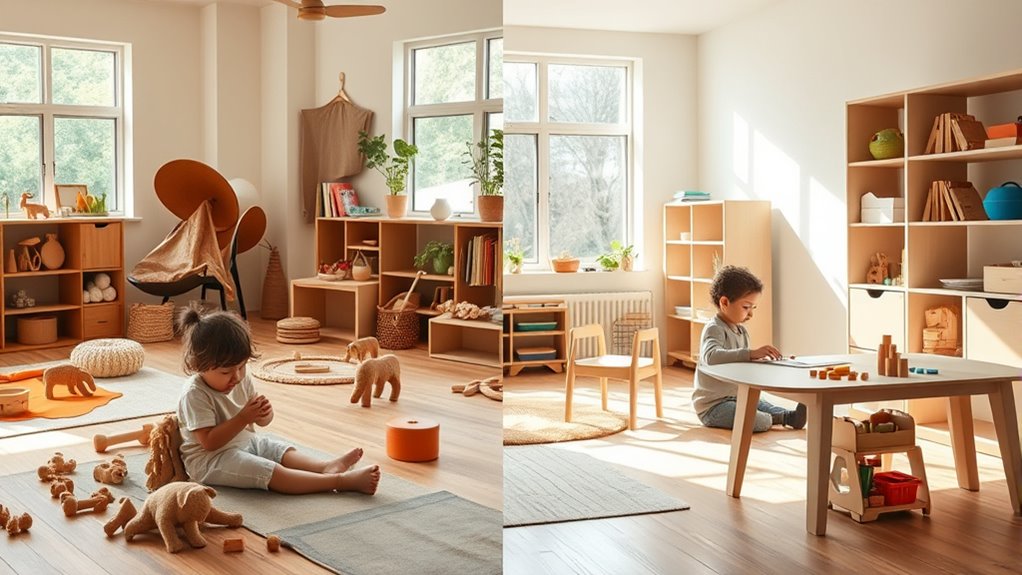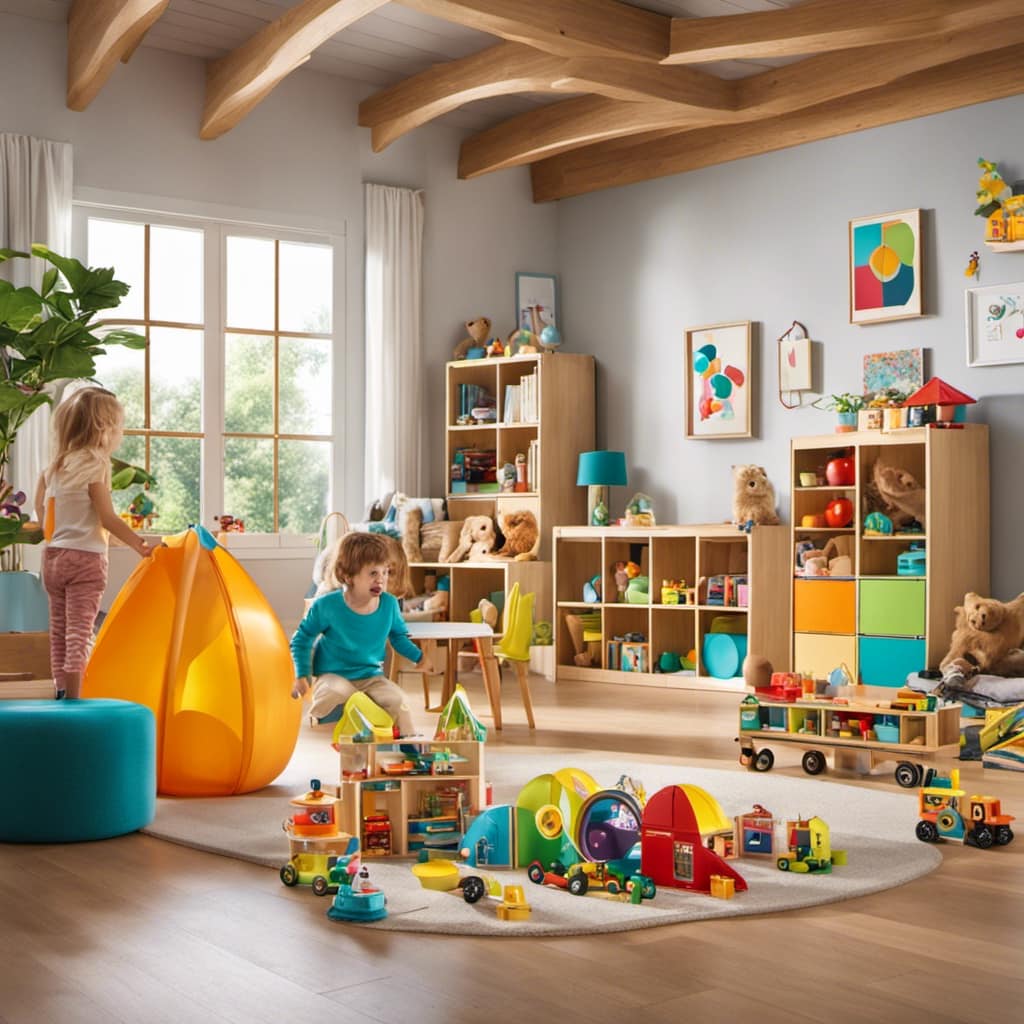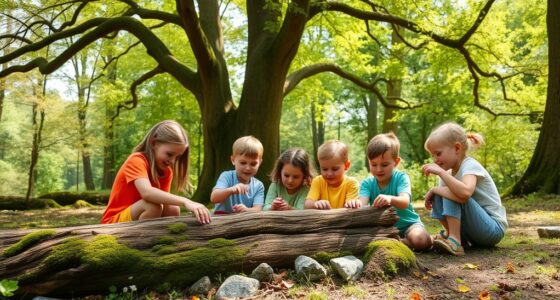Waldorf and Montessori play philosophies emphasize hands-on, creative activities but differ in focus. Waldorf incorporates artistic expression like storytelling, music, and dramatic play to nurture emotional growth and imagination through natural materials. Montessori uses tactile, self-correcting tools for independent exploration, promoting mastery and confidence. Both foster holistic development but approach play differently—if you want to discover how these methods shape children’s creativity and learning, keep exploring these unique philosophies more closely.
Key Takeaways
- Waldorf emphasizes imaginative, artistic, and sensory-rich play to nurture emotional and creative development, integrating storytelling and dramatic activities.
- Montessori promotes independent, self-directed play using tactile, self-correcting materials that support mastery and discovery of abstract concepts.
- Waldorf’s play often involves natural materials like wool and wood to enhance sensory exploration and emotional engagement.
- Montessori’s play focuses on practical life and manipulatives that foster independence, concentration, and problem-solving skills.
- Both approaches prioritize hands-on play but differ in goals: Waldorf fosters emotional and artistic growth, while Montessori emphasizes independence and cognitive mastery.

Are you trying to decide between Waldorf and Montessori education for your child? Both approaches emphasize the importance of play in learning, but they do so in different ways. Waldorf education places a strong emphasis on hands-on activities and artistic expression, believing that engaging children’s senses and creativity helps them develop holistically. In Waldorf classrooms, you’ll see children using natural materials like wool, wood, and silk, which foster sensory exploration. These materials aren’t just for fun—they’re integral to learning, helping children connect with their environment and develop fine motor skills. Your child might spend hours crafting with beeswax, weaving, or painting with natural pigments. These activities aren’t just about creating pretty artwork; they’re designed to develop coordination, patience, and a love for artistic expression. The focus is on nurturing the child’s imagination and emotional growth through creative pursuits.
In contrast, Montessori education emphasizes independence and self-directed activity, with a focus on concrete, hands-on learning tools. Your child is encouraged to choose activities that interest them from a prepared environment filled with manipulative materials that promote learning through discovery. While artistic expression is certainly part of the Montessori classroom—think painting, drawing, or modeling with clay—it’s integrated into a broader curriculum that emphasizes practical life skills, mathematics, language, and science. Montessori materials are designed to be self-correcting, allowing children to learn from their mistakes independently. The idea is to foster a sense of mastery and confidence as they progress through different levels of understanding.
Both methods value hands-on activities, but they channel that engagement differently. Waldorf’s artistic expression is woven into every aspect of the curriculum, often seen in storytelling, music, and dramatic play, nurturing emotional intelligence and creativity. Montessori’s hands-on approach is more structured around specific learning objectives, empowering children to explore concepts at their own pace with tactile materials that make abstract ideas tangible. If your child thrives through artistic expression and sensory play, Waldorf’s approach might resonate more with your values. Conversely, if you want a curriculum that emphasizes independence and discovery through practical, self-correcting tools, Montessori could be the better fit. Ultimately, understanding how each philosophy uses hands-on activities and artistic expression can help you choose the environment where your child will flourish creatively and intellectually.
Additionally, understanding sensory-rich environments can help parents appreciate how each method supports holistic development, catering to different learning styles and emotional needs.
Frequently Asked Questions
How Do Waldorf and Montessori Approaches Handle Children With Special Needs?
When supporting children with special needs, you’ll find that inclusive practices are central to both Waldorf and Montessori approaches. You adapt strategies to meet individual needs, using tailored activities and accommodations. Waldorf emphasizes creative expression and nurturing, while Montessori focuses on independence and sensory learning. By implementing these adaptation strategies, you create supportive environments that foster growth, ensuring every child feels valued and empowered to participate fully.
What Are the Teacher Training Requirements for Waldorf and Montessori Educators?
You might wonder what it takes to become a Waldorf or Montessori teacher. In both paths, you’ll need specialized training, including teacher certification, to meet curriculum standards. Waldorf training emphasizes holistic development and artistic skills, while Montessori certification focuses on child-centered learning and independence. Each requires completing accredited programs that prepare you with practical experience and in-depth understanding, ensuring you’re equipped to foster children’s growth according to their unique educational philosophies.
How Do Parent Involvement Strategies Differ Between Waldorf and Montessori Schools?
You’ll find that parent involvement strategies differ considerably between Waldorf and Montessori schools. In Waldorf settings, parent engagement often emphasizes community events and artistic activities, fostering a deep connection to the school’s philosophy. Conversely, Montessori schools encourage parents to participate in decision-making involvement, such as volunteering and contributing to classroom routines, which helps create a collaborative environment. Both approaches value active participation, but they focus on different aspects of parent-school relationships.
Are There Any Significant Cost Differences Between Waldorf and Montessori Programs?
Think of choosing a program as steering a pricing map. You’ll find that tuition costs and material expenses can vary quite a bit. Montessori schools often have higher tuition but fewer material costs, while Waldorf programs might balance lower tuition with more investment in natural, handcrafted materials. These differences shape your overall budget, so it’s wise to compare both tuition and material expenses carefully to make the best choice for your family.
How Do Each Philosophy Address Technology Use in Early Childhood Education?
You’ll find that both Waldorf and Montessori philosophies approach technology differently. Waldorf emphasizes minimal screen time, prioritizing hands-on, imaginative play to foster creativity and sensory development, which supports early digital literacy naturally. Montessori encourages guided use of technology when appropriate, integrating digital tools to enhance learning. Both aim to balance digital literacy with healthy development, but Waldorf tends to limit screen exposure more strictly, emphasizing real-world experiences.
Conclusion
Ultimately, choosing between Waldorf and Montessori is like picking between two beautiful gardens—you’ll find unique blooms in each. Waldorf nurtures imagination like a gentle breeze, while Montessori encourages independence like a sturdy oak. Trust your instincts to guide you to the garden that best suits your child’s growth. Whichever path you choose, remember that the right environment will help your child’s love of learning blossom like a radiant sunrise.











